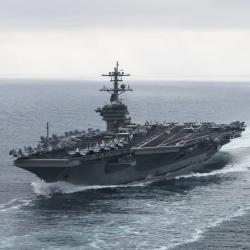 When the COVID-19 infection broke out on the aircraft carrier USS Theodore Roosevelt, the decision was made to test all the 4,865 sailors aboard the ship. As of today, the Navy says that 94% of the crew has been tested. The results were stunning. From an initial three infections, the number of sailors testing positive had risen to 660 or over 14% of the ship’s personnel tested. One of the crew, Chief Petty Officer Charles Robert Thacker Jr, has died. Another six sailors have been hospitalized and two are reported to be in intensive care.
When the COVID-19 infection broke out on the aircraft carrier USS Theodore Roosevelt, the decision was made to test all the 4,865 sailors aboard the ship. As of today, the Navy says that 94% of the crew has been tested. The results were stunning. From an initial three infections, the number of sailors testing positive had risen to 660 or over 14% of the ship’s personnel tested. One of the crew, Chief Petty Officer Charles Robert Thacker Jr, has died. Another six sailors have been hospitalized and two are reported to be in intensive care.
As disturbing as the total number of infections, there was something even more alarming. 60% of those who tested positive were asymptomatic – they showed no symptoms, no indication that they were sick. Why is this so troubling? According to new research, people with coronavirus infections may be the most contagious one to two days before they start to feel ill. One study suggests that more than 4 in 10 coronavirus cases are spread by those not obviously sick.
That 60% of the crew who tested positive was infected and contagious but showing no sign of illness explains why the infections spread so quickly in the crowded and cramped quarters of the aircraft carrier. But is there something specific about the conditions on the carrier that might account for the high rate of asymptomatic infections? Initially, the estimate of asymptomatic cases had been believed to be in the 25-50% range.
Test results from Iceland, where the government has tested a higher percentage of its citizens than in any other country in the world, suggests that the results may be typical. When Iceland was first hit by a coronavirus outbreak the government began aggressive testing and tracking using both targeted and random testing. Testing 10% of the population, they found that approximately 50% of those infected were asymptomatic.
By aggressively testing, tracking and isolating, Iceland has succeeded in keeping the spread of the virus under control.
Beyond getting similar results, the one thing in common on addressing the outbreak on the Roosevelt and in Iceland was testing. The United States has fallen behind most other industrialized countries in testing for the virus. On a per-capita basis, the US has conducted roughly one-twelfth of the number of tests compared to Iceland. Iceland also has one quarter the deaths from the virus, on a per capita basis, as the US.
New estimates by researchers at Harvard University suggest that the United States cannot safely reopen unless it conducts more than three times the number of coronavirus tests it is currently administering over the next month.

“That 60% of the crew was infected and contagious but showing no sign of illness explains why the infections spread so quickly in the crowded and cramped quarters of the aircraft carrier.”
Please check your math – ~60% of ~14% would be ~8.4% of the crew infected and contagious but showing no signs of illness. I think this number better illustrates the communicability of the infection.
No problem with math. Just prose. The previous paragraph said that “60% of those who tested positive were asymptomatic.” I thought the following paragraph would be clear that those were the sailors being referred to. To avoid confusion I have updated the following paragraph to the read “That 60% of the crew who tested positive was infected and contagious ….”
Even using 8% as the figure of contagious but asymptomatic explains why the virus spread from 3 sailors to 655 in such a short period of time.
Clarity improved. Excellent post, Rick.